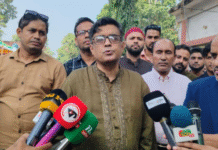Government set to miss its 2016 child labour elimination deadline by a big margin
The number of working children in the country has been on the rise despite a policy taken last year to eradicate child labour by this year.
Three years ago, the government identified 38 child labour-prone sectors in the country and vowed to ensure that there would not be a single child in active labour by 2016.
That vow had two parts: to eliminate child labour in hazardous jobs; and to fully eradicate the social curse.
The government claims that the readymade garment sector and the shrimping industry – two of the 38 sectors identified in 2012 – are now fully free from child labour.
However, some of the other sectors, including transport, still remain heavily dominated by child labour, many in hazardous jobs.
According to the latest child labour report published by Bangladesh Bureau of Statistics (BBS) last month, there are now as many as 3.45 million children in active labour in the country. Ten years ago, when the BBS published its last report, 3.2 million children were in active labour. So, in 10 years, child labour has increased by 250,000.
The December 2015 BBS report also says that 1.228 million children were engaged in hazardous jobs. In 2003, this figure was 1.3 million, showing that in 10 years the government has managed to remove 72,000 children from hazardous jobs.
Case study
Yesterday afternoon, 10-year-old Sujan, who works as the helper of a human haulier driver, was calling passengers near City College at the Science Laboratory intersection in Dhaka.
When this reporter, who was on a motorbike, caught up with Sujan, the little boy was literally hanging from the door of the human haulier, which was already moving slowly.
“Don’t you feel scared? You may fall on the road anytime!”
Sujan replied: “No Sir. Nothing will happen. I have been working for a year now.”
Asked why he does not go to school, the little boy said it was poverty – his father had left them years ago and his mother earns only a handful by working as domestic help and so he has to work.
Sujan’s daily income depends on the number of passengers; so on days when there are passengers in plenty, he earns up to Tk200. On less fortunate days, his income comes down to Tk100.
Before this correspondent could ask anymore questions, the human haulier sped away down the Mirpur Road.
The sleeping committee
In 2012, the government laid out the National Child Labour Elimination Policy 2015. The ambitious vow at that time was to ensure that no child would be working in hazardous jobs by the end of 2015 and there would not be any child labour at all by 2016.
A national coordination committee, comprising representatives from various stakeholders – the Labour Ministry, Women and Children Affairs Ministry, NGOs – was formed. This committee was tasked with forming district level sub-committees to work for eliminating child labour.
In three years, that committee has managed to sit for just two meetings although they were supposed to meet once every six months, and none of those district-level committees have been formed.
While talking to the Dhaka Tribune, Secretary to the Labour Ministry, Fazizur Rahman, admitted that they were nowhere near achieving the 2016 deadline they had set for themselves.
BBS report
Bangladesh Bureau of Statistics published the child labour report in December 2015, but the survey work was conducted in 2013 following the guidelines of the Bangladesh Labour Act 2006 and the conventions of the International Labour Organisation (ILO).
That report found that most children – 1.4 million to be specific – employed in hazardous jobs are in Dhaka, the capital city and the centre of all economic activities in the country.
The report also found that child labour mainly exists in five sectors: transport, warehousing, wholesale and retail business, vehicle repairing, construction, and mineral. In addition, 33.3% of the total child labour force is engaged in agriculture, forest and fisheries sectors.
The BBS found in the survey that most children drop out of school because their families cannot afford the expenses of education. Sometimes families take their children out of school thinking learning mathematics and English was less important than learning household work, specially for a girl child.
During a recent field visit to Cox’s Bazar, the biggest tourist destination in Bangladsh, this correspondent has found that one out of every six children in the district is school dropout.
When contacted, Education Minister Nurul Islam Nahid said they had ensured that nearly 100% of the children in the country are now going to school.
But many of those children drop out of school before completing primary education and get engaged in different types of work, the minister said.
“We are conducting various activities to bring back children to school. We have arranged financial benefits alongside food at school for children from poor families. We have also made arrangements for educating the street children,” Nahid said.
Source: Dhaka Tribune










